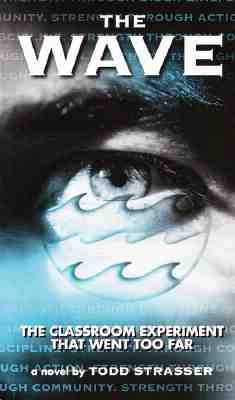 By MORTON RHUE (Puffin Books; 1981)
By MORTON RHUE (Puffin Books; 1981)
I have wo things to say about this slim novel: 1). It’s not very good, and 2). It’s one of the most chilling and unforgettable books I’ve read in some time.
THE WAVE by Todd Strasser (writing under the pseudonym Morton Rhue) has several strikes against it from the outset, in that it’s a young adult novel—meaning there’s all manner of crude prose and wooden dialogue that would never pass muster in a grown-up publication—and a novelization to boot (of an early-1980s TV movie). And yet the story it relates, based on an actual incident that occurred at a Southern California high school in 1969, is so powerful it can’t help but draw one in.
The setting is an apparently normal American high school, where one day a history teacher shows his students a film about Nazi Germany. In an effort to enliven his teachings, the teacher decides to perform an experiment: he creates a Nazi-like movement called The Wave, complete with a special salute, personalized slogans and membership cards.
The students take to The Wave with a disturbing amount of enthusiasm (the teacher’s real-life counterpart called it “one of the most frightening events I have ever witnessed in the classroom”), all-too readily giving themselves over to the group-think of fascism. Before long it sweeps through the entire school.
At first The Wave seems like a positive thing, as it helps motive underachieving students and puts unpopular ones on an equal footing with everyone else. But it also means intimidation for those who choose not to join the movement, and the school becomes an extremely scary and dangerous place.
Of course everything works out in the end, with the teacher who began the experiment managing to (unconvincingly) halt it by lecturing the kids about the error of their ways. Not being familiar with the particulars of the actual case, I can’t say if that’s how it really ended, but the coda feels trite and unsatisfying.
A brief afterward fills us in on some of the details of the real Wave. The location was Palo Alto, CA, and the teacher one Ron Jones, who wrote a play and short story based on the incident. I’m guessing the upheavals of the late sixties had some bearing on what happened (the infamous Stanford Prison Experiment, you’ll recall, occurred around the same time—and in the same town). However, no time frame is specified in the novel, nor any sense of what life might have been like for its characters in the ensuing years. Clearly a great (or even good) book on this subject has yet to be written, but until that book appears this one will make an adequate substitute.
